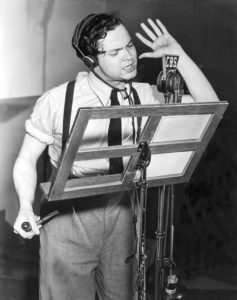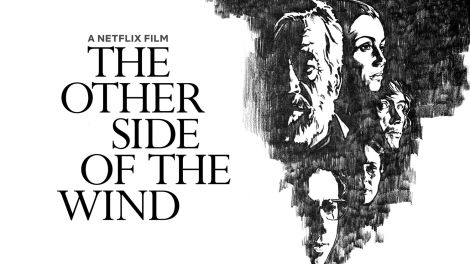The Other Side of the Wind, a film 40 years in the making has finally been released with the assistance of Netflix.
Unfortunately, this long-awaited film project delivers subpar entertainment.
Every college student needs a good distraction to turn to in between heavy workloads, and Netflix is a perfect source for that with titles both new and old for viewers to enjoy.
Netflix is known for funding and giving a platform for some of the most renowned creative minds in the entertainment industry. These creative minds provide Netflix with great, exclusive content that draws more people into their service. While some projects may soar (Stranger Things), others might crash and burn (Death Note).
The late, great Orson Welles’ final film falls short more than it soars.

Creative ideas can be risky, but the payoff can be revolutionary. Orson Welles had managed to change the face of cinema with the creation of Citizen Kane (1941), and there was the chance to do the same with The Other Side of the Wind‘s unique narrative style of having a movie unfold within a movie. In the 1970s, which was the intended time of release, this might of been more impactful than present day.
Due to roadblocks during the production process and Welles’ death in 1985, the film sat in limbo for 40 years and passed into legend.
The fabled film chronicles the last day in the life of Jake Hannaford (played by John Huston), a legendary director of a bygone Hollywood era.
Hannaford is a sardonic alcoholic who is starting to contemplate the legacy he is leaving behind. On his 70th birthday, Hannaford throws a viewing party for his last, incomplete project. An arthouse film called “The Other Side of the Wind.”
On paper, the concept of the film seems pretty interesting. Unfortunately, what could’ve been a great story is weakened by both messy film making and storytelling choices.
It’s only natural to feel excited when finally getting a chance to see a film that has been lost to time, but that excitement quickly dissipated.
The Other Side of the Wind contains some of the most jarring and disruptive editing that has ever been seen in an Orson Welles’ production, especially in the beginning of the film.
The scenes are spliced together like an incoherent mosaic of film stock both in black-and-white and color.
Yes, you read that right: the film has a tendency to jump from a classic Hollywood look to a more modern color approach. Maybe the constant change in color was supposed to be symbolic of the changing landscape of Hollywood at the time; out with the old, in with the new.
It would’ve been more powerful, though, if the use of color was utilized better in regards to their respective scenes. It seemed as if there wasn’t any reasoning as to why some scenes were in color and others not.
In addition, large amounts of dialogue are thrown at the viewer and multiple characters don’t get properly introduced at the start. The experience is similar to watching a bad home video without any context.
Without proper introduction, it’s hard to care for any of these characters. It doesn’t help either that no one in the film really has a unique and lovable personality. Many characters come off rather pompous and pretentious, such as Brooks Otterlake, who is Hannaford’s self-proclaimed apostle, (played by Peter Bogdanovich).

With only 18 minutes left of the film, a horrible realization manifested. Not a single character had managed to show any redeemable/likeable trait. It’s a problem when the viewer is at the end of a movie and they don’t care about any of the characters.
This all could’ve been solved with a better narrative that gives more insight into Hannaford’s relationship with each of the characters that work closely with him.
We’re not witnessing this story at the beginning or middle of a man’s life, but instead, at the very end. In order for a story such as this to work, the film maker needs to give the audience a chance to dive deeper into the background so that they can grow more attached to what is at stake of being lost at the end.
Citizen Kane is a great example of how to properly do that. The Other Side of the Wind, though, not so much.



You need to pay more attention to the movies you watch.
“Unfortunately, this long-awaited film project delivers subpar entertainment.”
Not every film needs to entertain you. Some can challenge you.
“The scenes are spliced together like an incoherent mosaic of film stock both in black-and-white and color. Yes, you read that right: the film has a tendency to jump from a classic Hollywood look to a more modern color approach. Maybe the constant change in color was supposed to be symbolic of the changing landscape of Hollywood at the time; out with the old, in with the new.”
The conceit of the movie is that it’s a found footage piece taken from all the film shot by film critics, young directors, and documentarians attending Hannaford’s party. That’s why the film stock changes — some students are using black and white, some are using color. This is literally spelled out in the first scene, the narrated prologue by Brooks Otterlake.
“In addition, large amounts of dialogue are thrown at the viewer and multiple characters don’t get properly introduced at the start. The experience is similar to watching a bad home video without any context.”
Or like you’re at a party and trying to piece things together as you go. That’s part of what the film is trying to do: immerse the viewer in the media frenzy surrounding Hannaford and filmdom while trying to make sense out of it.
“Without proper introduction, it’s hard to care for any of these characters. It doesn’t help either that no one in the film really has a unique and lovable personality. Many characters come off rather pompous and pretentious, such as Brooks Otterlake, who is Hannaford’s self-proclaimed apostle, (played by Peter Bogdanovich). With only 18 minutes left of the film, a horrible realization manifested. Not a single character had managed to show any redeemable/likeable trait. It’s a problem when the viewer is at the end of a movie and they don’t care about any of the characters.”
Again, that’s the idea: Everybody in the film is flawed, with some sympathetic elements. Not every movie you see needs to have completely likable characters.
“This all could’ve been solved with a better narrative that gives more insight into Hannaford’s relationship with each of the characters that work closely with him. We’re not witnessing this story at the beginning or middle of a man’s life, but instead, at the very end. In order for a story such as this to work, the film maker needs to give the audience a chance to dive deeper into the background so that they can grow more attached to what is at stake of being lost at the end.”
1. See above.
2. That’s the point. We’re witnessing the final hours of a great man, when his world collapses around him. The film’s focus isn’t so much on the man’s career and how he built up his own macho image and mystique, but rather how both collapse in front of his eyes, revealing a tortured (and deeply-closeted) monster underneath.
I know you’re going to reply with something like this: “Well, the movie doesn’t do a good job showing that he’s a ‘tortured monster’. He barely displays any emotions, except at random and when he’s drunk.”
But again, you have to keep in mind that he’s trying to keep his own self-image up in front of the documentarians. The most powerful moments in the movie are when he looks like he’s about to cry or break down, but immediately ducks out of camera range before he can let his true self be shown. As such, the film is not only a meditation on media frenzy and self-image in the face of said frenzy, but also an intimate glimpse at a great man’s final hours.
“It would’ve been more powerful, though, if the use of color was utilized better in regards to their respective scenes. It seemed as if there wasn’t any reasoning as to why some scenes were in color and others not.”
Building off my above comment, black and white documentary footage becomes more dominant as the film goes on. The party suffers power outages and more students shift to using black and white film (if you listen closely, you can hear students saying, “I’m not getting anything with color. What about black and white?”). During the power outages, Hannaford gets more and more information that his latest film odyssey is a failure and that his career is over. These being the most dramatic moments of the film, it’s only fitting that they be in black and white: We concentrate on the landscape of Hannaford’s face and eyes as he copes with the collapse of his livelihood.
Remember the scene with Zimmie and Matt Costello on the bus? Matt says, “Come on, Zimmie, Jake’s fine.” But Zimmie responds, “He’s turning sour, Matt. He’s going bad. I’m a make-up man, an expert. All my life I’ve been sticking my nose into other people’s wrinkles. I know the little signs.”
This is a clue for the viewer: You have to pay attention to Hannaford’s face.
Thanks for your comment! Your points are appreciated. Still, that doesn’t change the fact that this film did nothing for me. You mentioned that not every movie should be entertaining, which is something that I completely disagree with. What makes cinema so special is the power it has to immerse you into different worlds that tie your heart to the characters and events that unfold before you. That’s what movies and entertainment mean to me. If a movie isn’t entertaining, it has failed. Plain and simple. Unfortunately, The Other Side of the Wind failed in that regard, in my humble opinion of course.
Yes, a challenging movie is always welcomed, but a movie shouldn’t sacrifice entertainment in order to present challenging storytelling techniques.
By the way, I understand that movie characters aren’t supposed to be, as you put it, “completely likeable.” My second favorite film of all time is The Godfather Part 2, a movie filled with characters that are heavily flawed individuals. The difference is that Coppola used incredible film making to convey these characters. In my opinion, Welles didn’t.
At the end of the day, we share different opinions about this movie, and that’s perfectly okay! I’m glad you enjoyed Mr. Welles’ final production!
“That’s what movies and entertainment mean to me. If a movie isn’t entertaining, it has failed. Plain and simple.”
Then I guess we can start dismissing this world-renowned masterpiece on the grounds that some kid probably won’t get into it: https://www.youtube.com/watch?v=4PYE1k2yF3Y&vl=en.
Are you willing to do that?
As for immersion, Welles’s movie DOES succeed in immersing you in the crazy moviemaking atmosphere in which people are desperately trying to keep their self-image up in front of an omnivorous camera-clutching media. You’re literally waiting for Hannaford to betray some actual feeling, drop his public image, in light of his obvious obsession with Dale and how his career is collapsing as a result.
“The difference is that Coppola used incredible film making to convey these characters. In my opinion, Welles didn’t.”
But in that movie, there’s no media presence and filmmaking industry that’s constantly forcing the main characters to not be themselves. In Welles’s movie, the characters are trying to keep up their public image and let it slip. Hence, the moments where Hannaford nearly breaks down in front of Otterlake (before ducking out of camera range) and mockingly, frustratedly laughs.
How people can look at such a rich, thought-provoking concept and just dismiss it on the grounds that it’s “not entertaining enough” is beyond me. Yes, the film doesn’t develop characters like in Godfather Pt. 2 — but its mission is to deliberately skew it because of the found footage/character-camera interaction.
And HOW are you not moved by characters like Billy Boyle or Zimmie? They’re some of the most sympathetic, nuanced characters in the film!
You’re entitled to your own opinion, but not your own truth. You’re wrong about this film. Plain and simple.
I apologize for being so testy, but I meant what I said in that last message. By not giving this film a fair shot, you’re basically dismissing all the work that went into its production and release.
I’m not just talking about Welles here; Gary Graver toiled to complete the film, carting his own assembly around for years in the 90s and 2000s, before he died. Then there’s Filip Jan Rymsza, who pulled all the parties together in a move that was long thought to be legally impossible! And Bob Murawski, who replicated Welles’s editing style just for the movie.
If it isn’t good, none of that effort, that toil, that struggle was worth it.
I beg pardon for sounding so desperate, but: Please, please give this film one more shot. Think about it, come back to it and watch it once more. Those who have gotten into its rhythms and character development found a really powerful experience waiting for them.